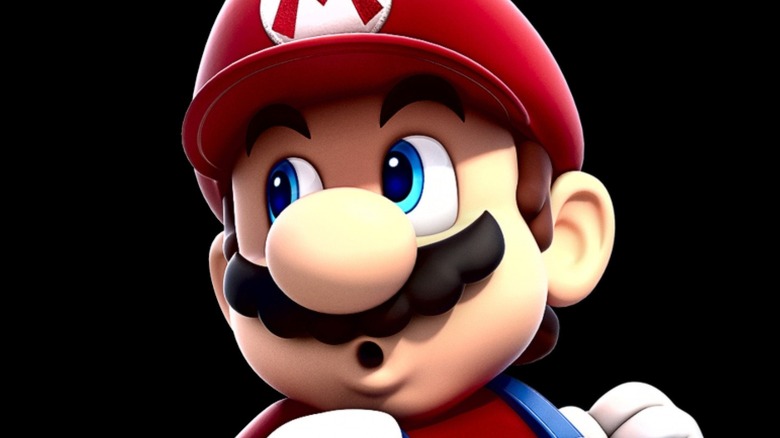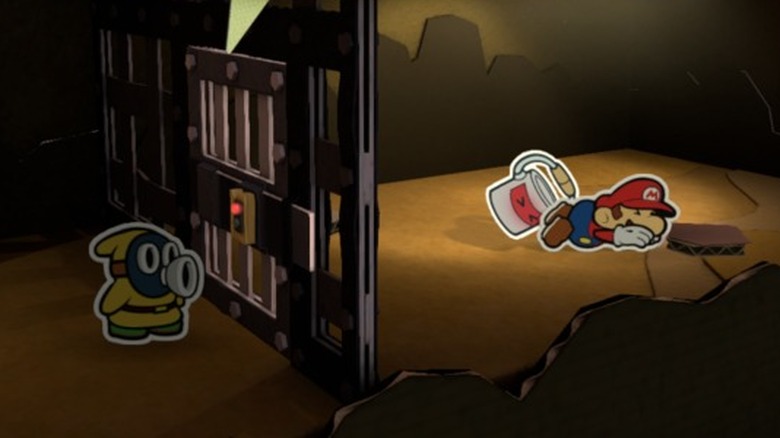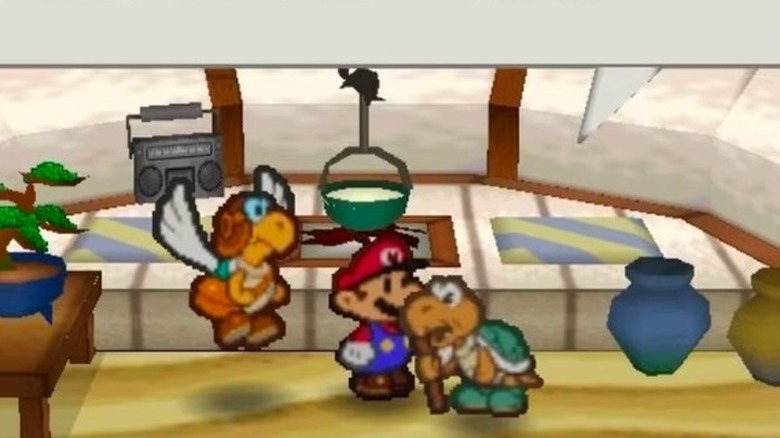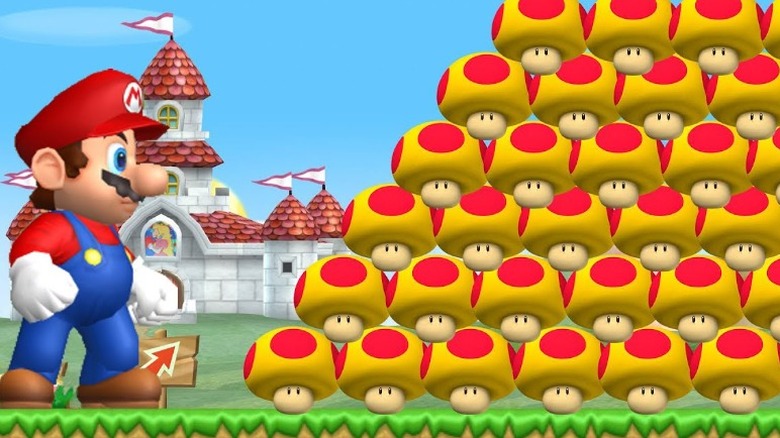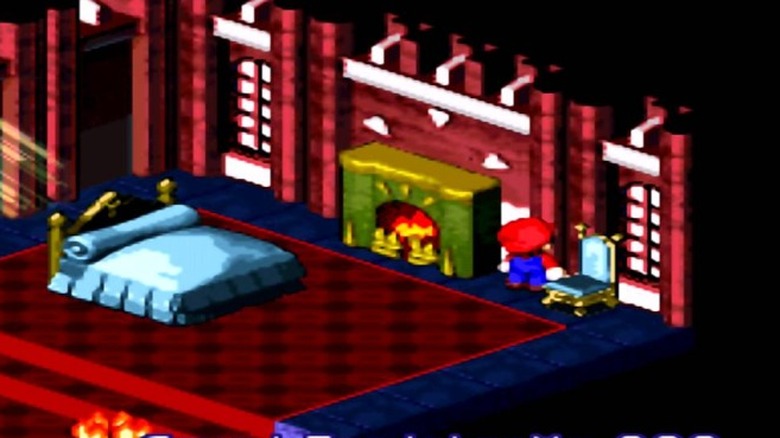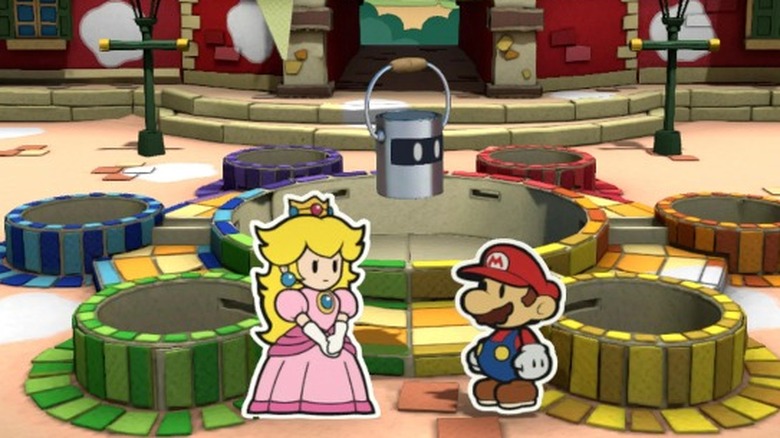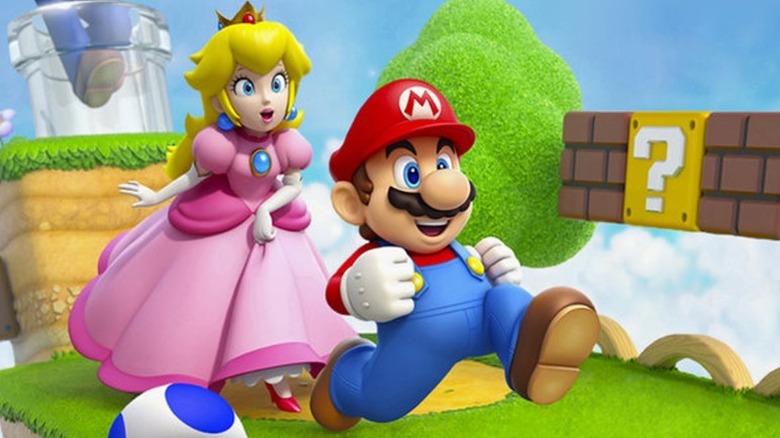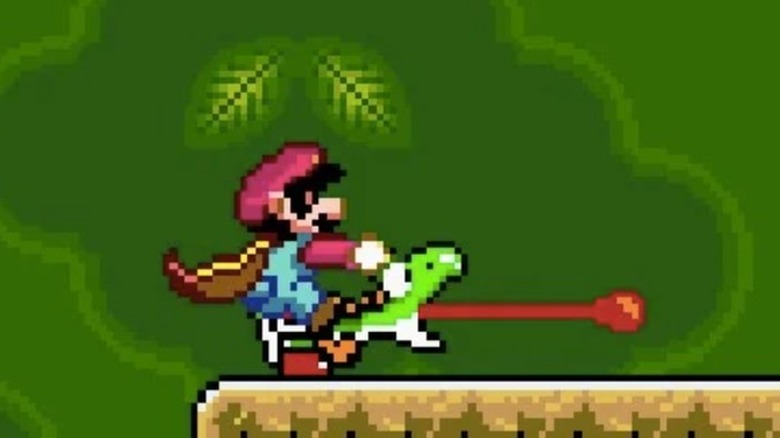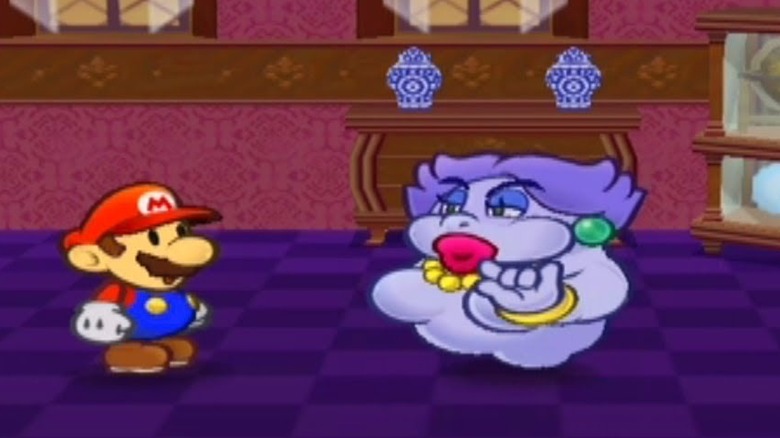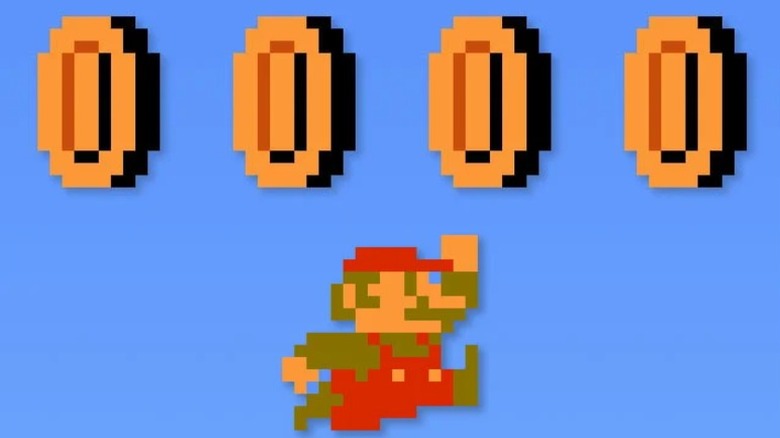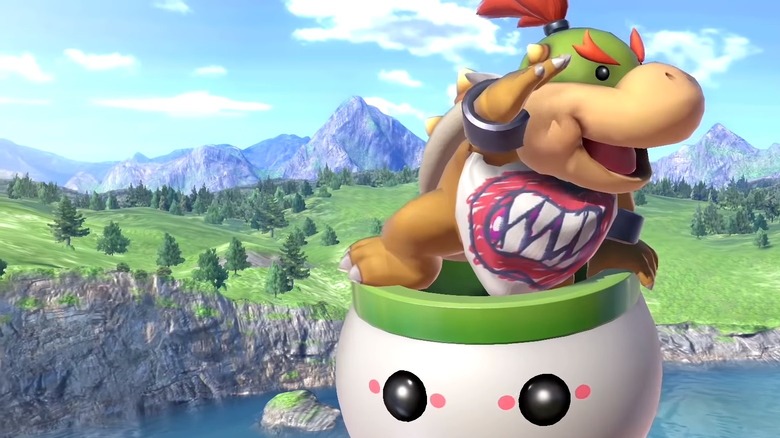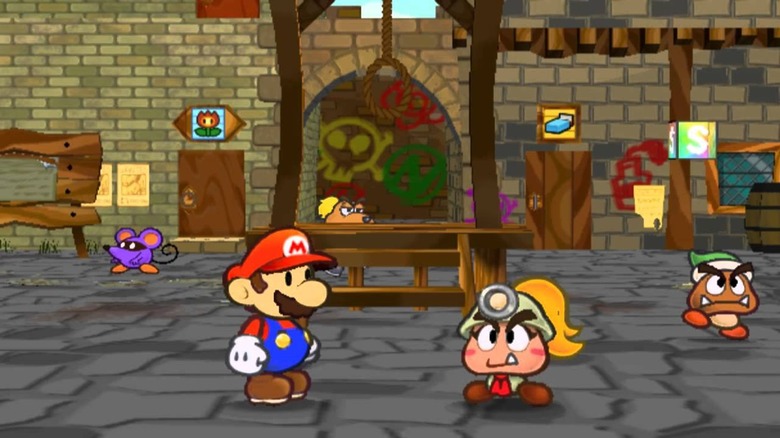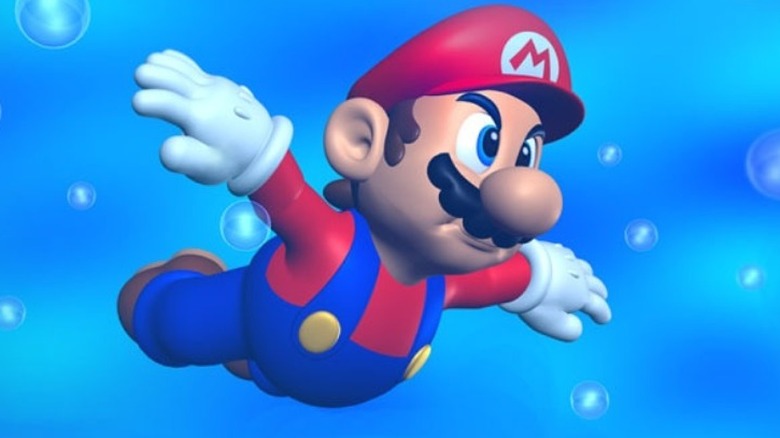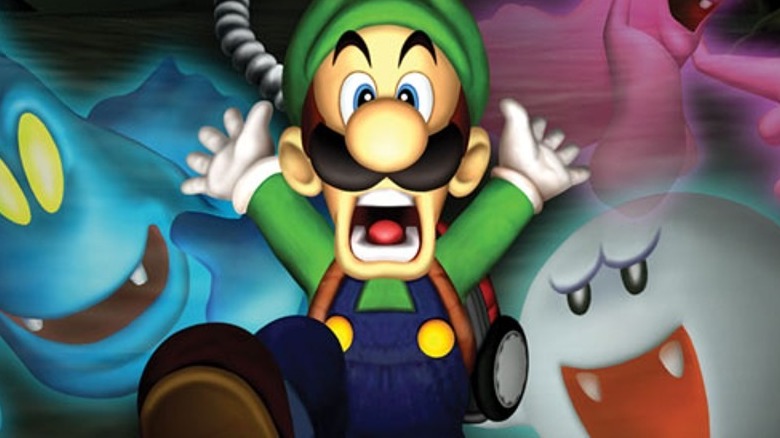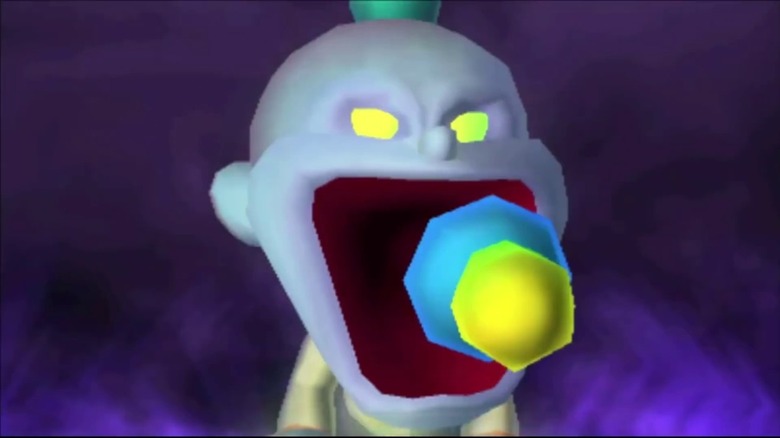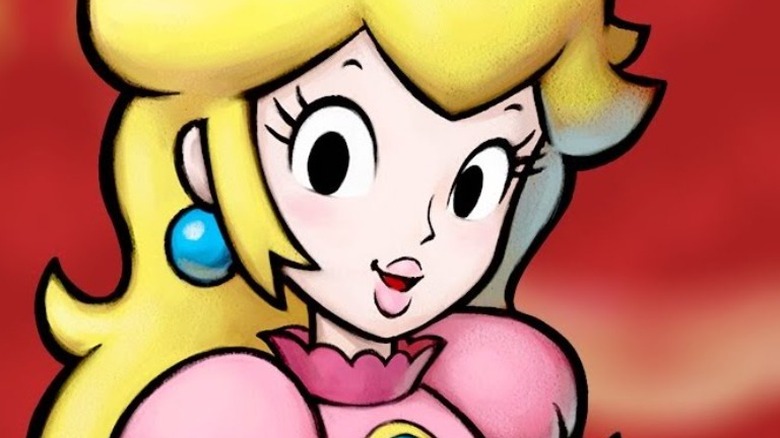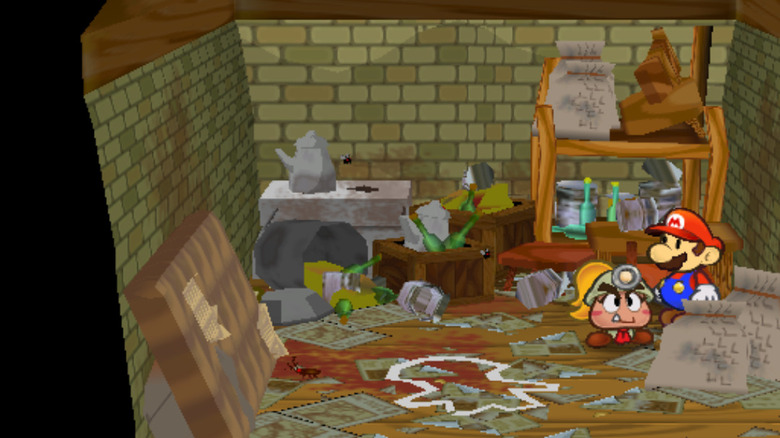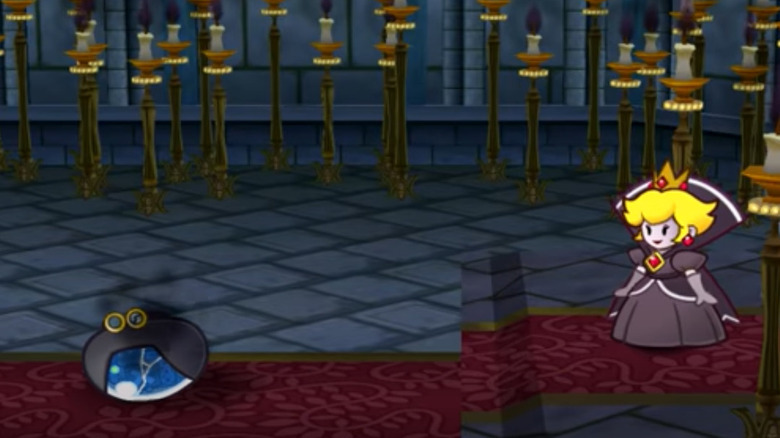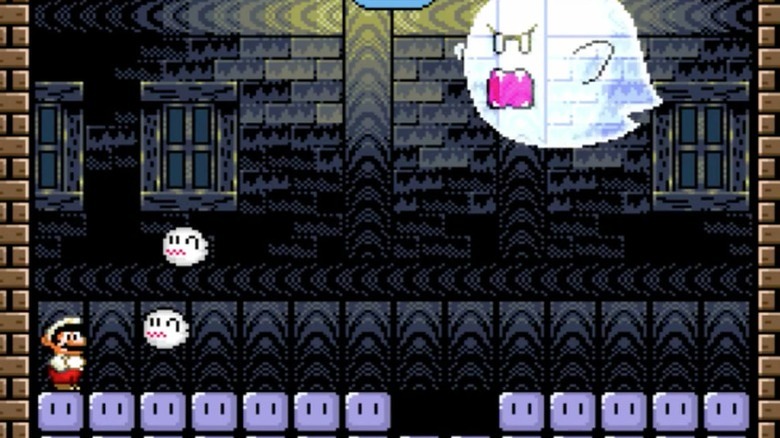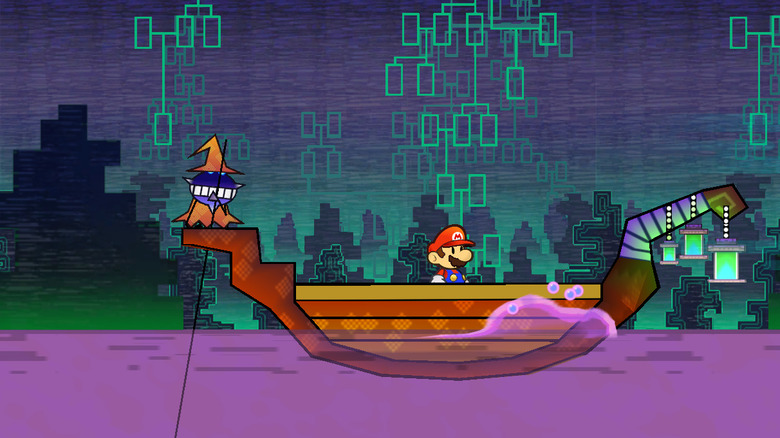Things Only Adults Notice About Mario
Nintendo is well known for being more family-friendly than its rivals. As noted by outlets like Nintendo Life, the company has made its family-friendly offerings and image a huge part of its brand identity. As such, the Japanese company's consoles are dominated by games that feature colorful worlds, wholesome mascots, and a lack of gratuitous violence. So it should come as no surprise that Mario, arguably Nintendo's most important character, has largely lived a rather sheltered life, free of any major controversies or moments that anyone would find offensive.
But while there's nothing overtly adult about the "Super Mario" series or its characters, that doesn't mean that the developers behind these games have made them entirely innocent affairs. If you look closely enough at the titles featuring Mario and pals, there are some rather glaring references that will fly straight over the heads of any children playing. With a little digging, the world of "Super Mario" is not always as charming and pure as it may initially seem.
That could be a deliberate decision on the part of those who make the games, allowing parents to chuckle as they play along with their kids or make connections that younger gamers wouldn't. Here are some of the things that only adults notice about the heroic plumber.
Mario goes to jail
The "Paper Mario" series has always been known for its ability to make players laugh. Out of all the games that feature the Italian-American plumber, it's these games that contain the most jokes and are likely to make players chuckle (as pointed out by The Escapist). This also makes them ripe for references or gags that might be missed by younger fans. A prime example of this comes in "Paper Mario: Color Splash," a 2016 game that was released for the Wii U.
Below Mustard Café in the game, Mario will be captured by Snifits and placed in a makeshift jail in a location known as the Snifit Undersand Hideout. One of the Snifits will threaten Mario, only to realize that they are limited in what they can do because of the game's ESRB rating of "E for Everyone." The Snifit remarks, "Well, I've already locked you in jail. There isn't actually much worse I can do without raising this game's age rating." This would seem to suggest that the Snifit wants to be a lot more violent to the hero than he is allowed to be, which raises all kinds of scary implications about what these guys do off-screen.
Koopa Koot's mysterious tape
In another example that comes from the "Paper Mario" sub-series, there's a reference to a mysterious tape that Koopa Koot once owned and lent to a friend of his. In the game, which was released for the Nintendo 64 in 2000, players can encounter Koot in the Koopa Village. He's an important figure, acting as the mayor of the village, and is also the oldest Koopa players can talk to. Koot will provide various quests by asking Mario for favors — and it is one of these very missions that might have caught the attention of any adults playing the game.
Koot asks the player to go and visit Goompa in Goomba Village and ask about an item only referred to as "The Tape." The exact contents of the tape and why it is so secretive is never revealed to the player, but Koot is desperate for it to be returned. He also begs the player not to discuss it with anyone else.
It is left completely up to the imagination of fans to decide what could be on such a tape, although the implications are that it contains nefarious or otherwise adult-only content that Koot is ashamed of, which is why he doesn't want other people to know about it.
Lots and lots of drug references
One of the more obvious adult references in any game featuring Mario is the rather overt reference to illicit drugs. Almost every single "Super Mario" game involves collecting mushrooms that can imbue a variety of effects on the user. One type will give player's an extra life, some will change your size and shape, and others can poison Mario and his allies. The only thing that is constant is that these mushrooms essentially alter the way that the characters interact with the environment in some way.
This has led to comparisons between the fictional mushrooms and real-life magic mushrooms, with Den of Geek noting that Shigeru Miyamoto has made links between the mushrooms in "Super Mario" and "Alice's Adventures in Wonderland" — a book that has its own links to recreational drugs (via BBC). While Miyamoto has walked back on those comments, many people still see the Super Mushroom and its variations as a reference to psychedelics.
It isn't just the mushrooms that seem inspired by drugs, either. In "Super Mario Bros. 2," players can throw potions that open gateways to another world. Meanwhile, the level "Touch Fuzzy, Get Dizzy" in "Super Mario World 2: Yoshi's Island" features spore-like creatures known as Fuzzies. When touched, they effectively make the player act as if they are drunk or high as the map is twisted, colors blend together, and moving around becomes much harder. Then, of course, there's an entire puzzle game about sorting pills in the form of "Dr. Mario."
Princess Toadstool's private item
The item known only as "Toadstool's ???" appears briefly in "Super Mario RPG: Legend of the Seven Stars." Like "The Tape" from "Paper Mario," this is a mysterious object that the player never actually gets to check out closely. However, gamers can make some informed guesses from the context and sparse clues that are offered by the in-game text or the actions of the characters.
When searching Princess Toadstool's room, it is possible to come across a hidden object between the fireplace and a blue chair. Examining it will cause either the Princess or her Grandma to get onto Mario, saying, "Mario! Stop peeking into other people's rooms!" The Grandma may even try to bribe the player with a mushroom to refrain from exploring further. This suggests that the item in question is personal to the Princess and deeply private, as this is the only explanation that would cause such anger from her.
Considering that Toadstool's "???" is found hidden in her bedroom, some fans have inferred some rather raunchy possibilities.
Mario is Peach's...friend
Mario and Princess Peach certainly have a strange relationship, to say the least. Since the release of "Super Mario Bros." in 1985, the plumber has consistently set off to rescue her from the clutches of Bowser (or any other villain) for seemingly no reward or reason. While heroes love to save the day, the fact that Mario is very much a constant presence alongside Peach and attends lots of personal events with her would lead players to believe that they are actually a couple, even if it's a complicated topic. It's a situation that Nintendo has never officially explained, leading to speculation about whether they are a couple or enjoy a more platonic relationship.
However, there is one reference that might indicate how Peach really feels. In "Paper Mario: Color Splash," the Princess introduces Mario to the player and the magic paint can by saying: "And this is my...friend Mario. He jumps on things and hits them with a hammer when necessary." The way that she pauses before deciding to call Mario simply her "friend" is clearly a reference to the all-too-common trope about two people being "just friends" when they actually share romantic feelings for each other. There's really no other explanation for the subtext of the dialogue.
Humans seemingly rule over the toadstools and other creatures
Much of the action in the "Mario" series takes place in the Mushroom Kingdom, a fictional land that features a variety of different species and races. The most common of these are the Toads, which are often seen in the games as allies of Mario and Peach, along with other creatures such as Goombas, Yoshis, and Koopas. One thing that is immediately clear is that the vast majority of individuals in this fictional country are decidedly non-human. And yet, the Mushroom Kingdom is ruled by Princess Peach, with the likes of Mario and Luigi often taking up positions of power. This has led to plenty of fan discussions asking exactly why that is the case.
An old post by College Humor pointed out that the human leadership over the Mushroom Kingdom has some troubling imperialist connotations. Exactly how did Peach and other humans end up ruling a place that seems completely devoid of humans? Pretty much the only other people we ever see in any of the "Mario" games are Daisy, Wario, Waluigi, and more recently Rosalina.
With that in mind, Peach and her family almost seem like they set themselves as monarchs, subjugating the other species under them. As her enforcer, Mario is just as complicit in this scheme, ruling over every non-human. No wonder Bowser keeps kidnapping her and fighting against the established regime! As noted by Twinfinite, he could easily be seen as a liberator attempting to win back the freedom of his people.
Mario is actually pretty cruel
Mario is one of the world's most famous video game mascots, instantly recognizable around the world. Few other fictional characters have the kind of fame that this plumber enjoys, and much of that is built on the fact that he is the consummate hero. And yet, if you look closely at some of the things that Mario has done over the years, he might not be the perfect guy that he makes out. Firstly, you can look at the way he treats his brother Luigi, constantly berating and mistreating him (via The Gamer).
Mario has also demonstrated a habit for being unkind to the animals that he encounters. In the 1981 arcade game "Donkey Kong," players control Mario as he tries to rescue his girlfriend Pauline from Donkey Kong. Nintendo Link reported that the original manual for "Donkey Kong" — plus a subsequent game called "Donkey Kong Circus" — pointed out that the ape only kidnapped Pauline as revenge against Mario for being treated so poorly when he was Mario's pet.
Even worse, adult gamers might have noticed in "Super Mario World" that it appears as if Mario is punching Yoshi in the back of the head when he wants him to stick out his tongue to eat an enemy or item. While there has been some debate about what is actually happening during this action, Shigefumi Hino actually confirmed to the official Nintendo site (translation via Kotaku) that the original design had Mario hitting his dinosaur pal.
Madame Flurrie has a lot of stage presence
This particular example is another one that uses ellipses in dialogue balloons to subtly add extra meaning to something that has been said. In "Paper Mario: Color Splash," it was used to suggest Mario might be more than a friend to Princess Peach, while here it is a reference to the design of the character Madame Flurrie. Acting as the third individual who can join Mario's party in "Paper Mario: The Thousand-Year Door," she is a wind spirit that has the power to blow away opponents with powerful gusts.
When first introduced to the player, the game explains some of her abilities to the player and goes on to state that "she can also do a Body Slam in battle, squashing enemies with her...stage presence." This is almost certainly a gag that is referring to her busty design, as well as the fact that she was formerly an actress. Few other characters in "Mario" games have as shapely a figure as Flurrie, but only adults will fully understand the subtext of her in-game description when combined with how she looks.
Things don't get any less inappropriate when Mario blows into her to use one of her abilities, either.
Mario must be really rich
While there's no traditional currency in the "Mario" games like there is in real life, there is certainly an abundance of gold coins scattered throughout the world. In fact, Mario can collect thousands, of these coins throughout his adventures across the Mushroom Kingdom and beyond. It's not like these gold coins are worthless either, as they can be used to buy things from stores in titles such as "Paper Mario," "Mario Party," and "Super Mario RPG: Legend of the Seven Stars."
With so many "Mario" games available on the Nintendo Switch and older consoles, Mario could easily have amassed quite a fortune over the last four decades — a fact that kids who are playing the games will likely have missed completely. The only issue comes with assigning a value to the coins.
According to Movoto (via The Boar), the coins have a value of $508,000, with that figure being calculated based on the dimensions of the item and how much gold that would equal. Net Credit used a different method, formulating the value of each coin at $80,000. In either case, that makes Mario one of the richest video game characters of all time, with a conservative net worth of $800 billion, although Forbes suggests a much lower (but still wealthy) $1 billion.
Bowser Jr.'s mama woes
Bowser Jr. was originally introduced in "Super Mario Sunshine." Throughout the game, he utilizes a disguise known as Shadow Mario and functions as its main antagonist. His Shadow Mario form makes him look exactly a strange, watery version of the titular protagonist. He uses the form to get in Mario's way throughout the game's storyline, all in an effort to keep him from rescuing Princess Peach. The reason for his interest in doing so is revealed at the end of the game: Bowser Jr. believes that Peach is his mother.
It seems that this is actually false, because Princess Peach responds to the claim with shock and borderline horror. If Princess Peach really was Bowser Jr.'s mother, it would stand to reason that she would know about it. However, the implication of Bowser telling his son that Princess Peach is his real mom is loaded with all kinds of uncomfortable implications, especially when it is thrown in at the end of an E-rated game. It also would be very easy for a player shocked by Bowser Jr.'s claims to completely miss Princess Peach's surprised reaction.
All of Rogueport
In "Paper Mario: The Thousand-Year Door," the city of Rogueport serves as a hub for the player's journey. Throughout the game, players return to Rogueport to gather supplies, complete side quests, and check in with their allies before continuing the story. However, the city has a ton of mature details that make it seem like it would be more at home in a game like "Grand Theft Auto" than a "Super Mario" spin-off title.
Characters throughout the game frequently refer to just how rough and shady of a town Rogueport is, and the developers went to great lengths to illustrate this for players. The streets of the town are filthy and covered with trash and random scraps of paper, which is particularly odd for a game where living creatures are made of paper. The walls are covered in graffiti, and players can even witness muggings happening in broad daylight. The real cherry on top, however, is the actual noose and gallows in center of the town, just waiting for a criminal's neck. Kids might see this as old-timey set dressing, but older players will probably realize quickly that they should avoid the back alleys of Rogueport.
Mario drowns
Any "Mario" fan who played "Super Mario 64" as a child probably has a specific death animation burned into their memory. Before the series made the revolutionary jump to full 3D, Mario's death animations were relatively simple and inoffensive. In the earlier games, Mario would get hit by an enemy or hit a hazardous object before yelling and falling off the screen with a bit of music to accompany it.
However, with the arrival of "Super Mario 64," the developers decided to use the game's new 3D models to portray Mario's demise in more detail than ever before. The animation that incorporated the most disturbing realism occurred when Mario ran out of air while underwater, causing him to drown. The animation sees Mario slowly stop swimming as he grabs at his throat, desperate for air. He then kicks around for a while before falling limp and slowly sinking to the bottom. Players can even hear him make a few weak struggling sounds in his final moments, which are quickly followed by the sound of Bowser laughing at Mario's death.
A lot of effort went into making this the most visceral and impactful way for Mario to fail.
Luigi's deathly shadow
One of the more surprisingly dark moments throughout the franchise comes thanks to a very common glitch in "Luigi's Mansion." The glitch can be found in a completely dark room. To navigate through this part of the mansion, players have to wait for lightning strikes to provide momentary glimpses of the layout. The eventual goal is to reach a telephone on a small table at the center of the room.
Lightning continues to strike while Luigi talks on the phone, but a glitch with the game's perspective and lighting provides one of the most startling scares in the game. At its core, the glitch just causes Luigi's shadow to animate higher than it should be. However, this makes it look like the shadow shows Luigi's corpse after being hanged. This is incredibly dark for a children's game, even one that aims for more horror elements than a typical "Mario" title.
The glitch has led dedicated fans to formulate numerous theories about what it could mean for the plot of the game. The most popular of these is that Luigi is actually dead at the start of the game, which would offer a new explanation of how he got to a strange house filled with ghosts.
Baby ghost boss fight
"Luigi's Mansion" features a lot more creepy and horror elements than most games throughout the franchise, which makes perfect sense. After all, the game sees Luigi delving into a haunted mansion and contending with various ghosts while searching for his lost brother Mario. Some of these spooky encounters involve boss battles against extra-eerie spirits. Each of the bosses is a member of the family that most recently lived in the house — the third of which is the large ghost of a baby named Chauncey.
This boss fight is incredibly unsettling, especially for a game that can reasonably be expected to be played by children. To start, the question of how Chauncey died at such a young age is unavoidable. Players are led to wonder about what sort of terrible fate Chauncey met, and exactly when its short life came to an end. The madcap tone of the game may mask some of the weirdness for kids, but this is still a morbid subject for a "Mario"-adjacent game to explore.
Peach's public execution
Early on in "Mario and Luigi: Partners in Time," Princess Peach is kidnapped by the game's alien antagonists. While trying to rescue her, Mario and Luigi follow her to an arena filled with bad guys. Although the dialogue of the aliens is written in incoherent symbols, players quickly get the sense that something terrible is about to happen.
Suddenly, a UFO brings Princess Peach into the arena and holds her over a massive green pipe in front of the crowd. Then, the crowd begins to chant as the tension rises and players begin to really worry for Princess Peach. As the crowd's chants reach a fever pitch, Peach is dropped into the pipe, which houses a monstrous Piranha Plant. And with that, players ostensibly watch Princess Peach be publicly executed and eaten alive.
It is later revealed to the player that Princess Peach actually survived the whole debacle, but upon first playing, it really does seem like she has been killed for good — to the delight of everyone gathered. It feels like something out of the Dark Ages, aliens notwithstanding.
Toad murder
In most versions of "Paper Mario: The Thousand-Year Door," players exploring Rogueport can find a shed that is filled with overturned furniture and loose papers. The purpose of the shed is never further explored, and there is no reason stated for its strange interior. Players are instead free to assume whatever they want about what happened there, such as a robbery or just general uncleanliness, since it doesn't look that much worse than even the nice parts of Rogueport. Older players will definitely get a sense of unease about this place, though — especially if they're playing an uncensored release of the game.
"Thousand-Year Door" players in Japan received a pivotal clue to what happened in this room. In the Japanese version of the game, it is seemingly revealed that the shed was actually the location of a murder. A chalk outline of a Toad can be seen on the floor. That isn't too bad in itself, but the floor also has an added splatter of some dark red substance that appears to have dried.
While one could argue that the liquid is some other miscellaneous fluid, Nintendo's removal of the detail for the North American release seems to imply otherwise — and adults who watch enough cop shows would probably agree.
Dark Princess Peach
Another frightening scene — one that many may view as too graphic for children — occurs near the end of "Thousand-Year Door," when the player follows the game's main antagonist and Princess Peach to a cavern. There, a being known as the Shadow Queen possesses Princess Peach, giving her a goth makeover and taking control of her body. We've all had that one friend who tried to reinvent themselves, but this is ridiculous.
The really upsetting moment comes when the villainous Sir Grodus tries to give her commands. The Shadow Queen doesn't take his presumption of power over her very well and opts to kill him in retaliation. She makes him entirely disappear, only leaving behind what is either his helmet or his head behind, which smolders and bounces on the ground in the absence of his body.
It can also be difficult to look at Princess Peach or trust her in the same way after seeing this scene. Obviously, Peach wasn't in control of herself when she killed him, but it still very much looks like her — and the image of her decapitating an enemy in cold blood is one that can be difficult to shake.
Dead creatures are seemingly trapped after death
In early "Super Mario" games, most of the enemies were living creatures who were variations of Goombas, Koopas, or the fish-like Cheep Cheeps. Things started to change with the release of "Super Mario Bros. 3," which saw the introduction of Boos and Dry Bones. There are two undead enemies that can attack Mario, with Boos being ghostly creatures and Dry Bones the withered skeletons of Koopas. From that point on, the franchise has included many different types of dead enemies that are seemingly re-animated or trapped in some way in the land of the living.
This essentially means that Mario is constantly surrounded by death. Some may argue that Boos are just a species of ethereal beings, but the fact that there are specific Boos that match up with living creatures suggests otherwise. For example, there are Boo Guys that come from Shy Guys and Fishin' Boos from deceased Lakitus. Other undead creatures Mario can encounter include Polterpup and Bonneters, as well as bosses such as Kingfin, Doopliss, and Dry Bowser (who raises a ton of questions on his own).
To make matters worse, a character named Goombario in "Paper Mario" states that a particular Boo called Igor was "probably was a merchant before he became a Boo." This confirms that Boos are actually dead Mushroom Kingdom inhabitants. With that in mind, it's safe to assume that other undead characters were once living too, but are now forever destined to roam the sewers and castles of the kingdom.
Drag Mario to Hell
Toward the end of the main story in "Super Paper Mario," Mario and his friends are outright killed by the game's antagonist in a series of explosions. This sends Mario to the game's equivalent to Hell, cheekily referred to as "The Underwhere." Mario has to find and save his friends from this world and its Queen.
While The Underwhere is not nearly as graphic or spooky as most depictions of Hell in pop culture, it is still definitely a setting that many parents would not want their kids experiencing in a video game. The game is also explicit in explaining that there's also a realm called The Overwhere, which is a clear analogue for Heaven. In other words, the game definitely spells out for savvy players that Mario has to take a little trip through Hell itself to save the universe.
The inclusion of The Underwhere is also particularly interesting because of the implications it carries for the wider "Mario" universe. Ghost and skeleton enemies are featured throughout nearly every "Mario" game, including "Super Paper Mario." If there is an afterlife, however, it begs the question of what those spirits did to end up trapped in the regular world instead of moving on.

